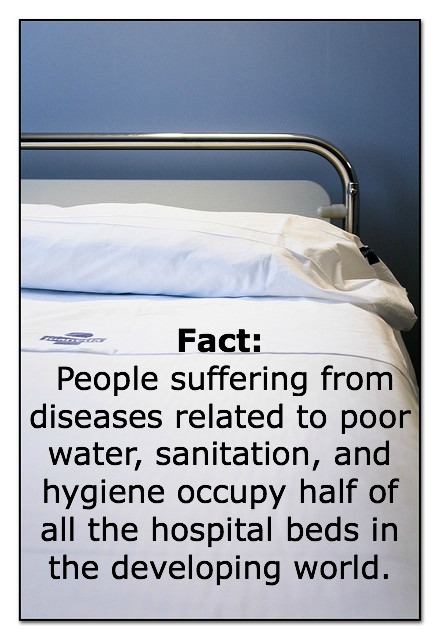 |
Sustaining Today’s Wells Beyond Tomorrow: Part One Financial Sustainability
by Nick Baldry
As I write today it is hot: I have to remind myself that it is a luxury to be able to potter through to the kitchen and turn a conveniently located tap to get a glass of water. It's a luxury I have because the local infrastructure is well funded enough to keep it in good repair. Should that infrastructure fail, it would be an inconvenience rather than a disaster with bottled water available in abundance. Others are far less fortunate. The villagers Wells Bring Hope serves in rural Niger don’t have the option of buying a few liters of water from the nearest store. Their journey for water is likely to be many miles on a highly unsafe route, and the end result is water that is often unclean to the point of being life-threatening.
In such a context the sustainability of the wells that Wells Bring Hope drills is a hot topic. Once we provide a clean water supply, it would be cruel beyond imagination for that supply to fail down the line. We are not the only ones thinking along these lines as this summer’s release of the GLAAS 2012 report has prompted much discussion on sustainability across the WASH sector. It is worth looking at what processes Wells Bring Hope has in place to ensure that our wells are truly sustainable as well examining best practices in the broader WASH sector.
For Wells Bring Hope, sustainability means that a hand-pump well is still fully functional, without ongoing external support, at the end of its advertised life. In simpler terms, this means that the well is still working properly at least 20 years after installation.
One of the key factors in maintaining the sustainability of a well is ensuring that it is financially sustainable, a factor that is all too often neglected.
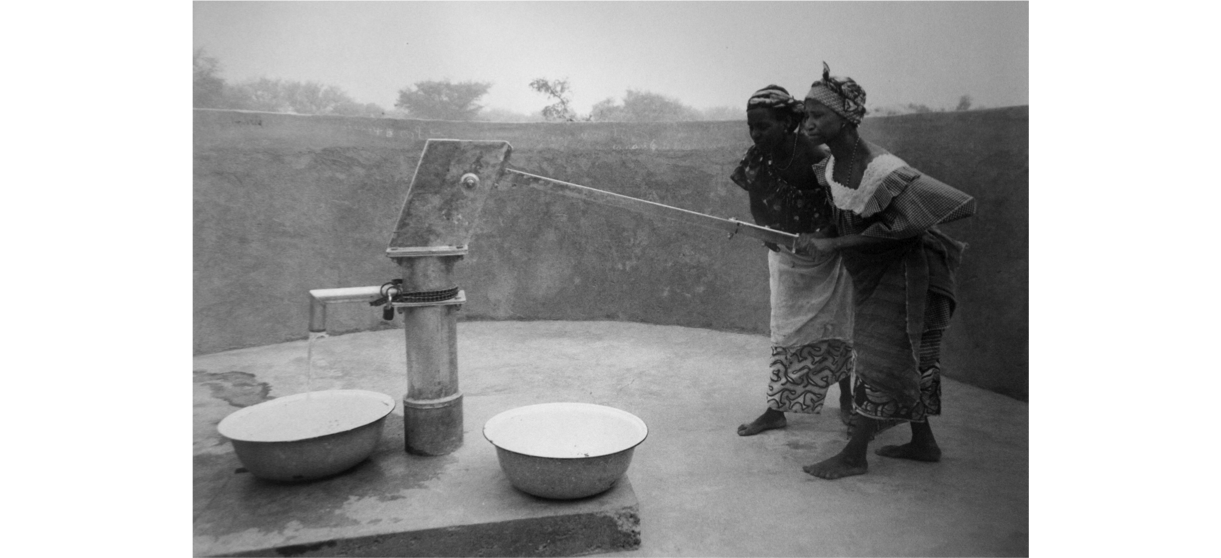
{photo by Gil Garcetti} |
Between the first Glass report in 2010 and the most recent edition, WASH funding has risen slightly; however, there are major issues in terms of financial sustainability in the sector. The vast majority of funds are channeled into new capital expenditure and increasing capacity building while only 31% goes into operation and maintenance costs. While increasing capacity is a vital part of increasing access to clean water and sanitation, such lopsided investment means that today’s new wells may very well be joining the legions of non-functioning facilities in a few years’ time. In a recent webinar hosted by sustainableWASH.org Catarina Fonseca estimated that, at present, 40% of rural systems are non-functioning, that represents $744 million dollars’ worth of investment that is currently wasted as wells lie in disrepair, failing to provide their vital service to rural communities.
Wells Bring Hope has a track record far superior to the 40% failure rate quoted by Catalina Fonseca. Out of 174 wells drilled since 2008, 174 are fully operational at the time of writing. A large part of that is the result of the appropriate use of technology (an important topic, which will be expanded upon in a later blog), but another key component is the primary role that the local community takes in maintaining the well and ensuring its financial sustainability. Prior to drilling, a committee is established to run the well, and a small charge for service is levied on all users. The committee then uses this money for maintenance and any necessary repairs. Without this small, community-generated fund, repairing and maintaining the well would be impossible, and without this maintenance, the wells useful life would be dramatically reduced. In addition our partners at World Vision work with each village where we drill for at least 15 years. Part of that continued work includes monitoring and evaluating the well to ensure that it is in working order.
Drilling a well, holding a grand opening for a well, maybe even dedicating a well to a donor or someone of importance in the local community is the headline grabber, the glamour part of the job. That is a massively enjoyable part of what we do and that is why, in the broader WASH sector, the majority of funding goes to well drilling. Who wouldn’t want to be part of that? Ensuring funding is in place long-term is not quite as thrilling. No one comes and pats you on the back for ensuring that a well has a long-term funding plan. That doesn’t change the fact that without making a well financially sustainable, the fanfare that went with your grand opening was merely a false dawn for the village where you drilled. The truth is that taking the time to make sure a new well will last is as important as drilling it in the first place.
Imagine
by Kevin Shi

{source: benat…} |
Imagine a beehive.
Begin with the queen. She sits, bloated and sore, in the center of the hive, watching her children, a matriarch both ruling over and subjugated by her family. Around her the swarm revolves. She births larva daily. Seven out of eight bees are female. They are soldiers, workers, nurses, scouts. They gather food for the hive and care for the young. They execute robbers. Their responsibilities are enormous; everyday the females must labor to preserve their family.
The eighth bee, the male, is born genetically incomplete. He lives, he mates, he dies. His body is swept away. The queen births again. When the workers must make a choice on whom to save when the hive is in danger, the order goes as follows: their queen, their sisters, their food, their hive, their brothers. Those who are not dead already by late autumn are rejected from the hive, to die in the cold of the winter.
Imagine one gender that works day and night, indefatigable, tireless. Imagine members of one gender giving their whole lives to labor just to survive.
Then imagine one gender suppressed, objectified, devalued. Imagine one gender used, then discarded.
Imagine us.
In developing countries like Niger, women are victims of forced marriage, violence, and sex trafficking. The burden placed on women is enormous. Everyday, mothers must walk miles just to give their children something to drink, massive amounts of effort expended on such a basic human necessity when school books remain untouched and pockets remain empty.
|
{photo by Gil Garcetti} |
It’s strange to think of women as both the worker and the drone. Conferred upon them are all the responsibilities of the female bee, and at the same time all the disadvantages of the male. Endless labor that begets endless subjugation: this is no way to live. Drought has come again to Niger as winter comes to bees. There is no doubt as to who shall suffer first.
Compared to Niger, the United States seems almost paradise, but the same problems exist here. Barely 3% of Fortune 500 CEOs are female. Men outnumber women in the Senate four to one. Discrimination and sexism exist everywhere.
But, here’s a little secret: we’re not bees. For us, biology need not dictate destiny. We can change things. We don’t have to live in a world of bigotry. We can make different choices. Wells Bring Hope is trying to help where help is needed the most. Providing a village with safe water is the first step to leveling the playing field for women and girls. When they no longer have to walk for water, they can dedicate themselves to their education and to productive, income-generating work.
If you can’t give abroad then maybe you can start right here. On October 11, Day of the Girl will break down gender stereotypes, building foundations for girls everywhere to reach their full potential. First steps on the road toward equality. A chance to give opportunities to people who have known nothing but rejection. The beginning of change for the better.
Imagine that.
 |
Beverly Hills Women’s Club Event – Sept. 22, 2012
Photos and text by Jessica Isaac
After attending the Bel Air Crest event hosted by Firouzeh Banki and Curtis Estes earlier this year, guests Alan and Mandana Azad were inspired to host their own event in honor of Wells Bring Hope. We are happy to report the two did just that with much success on Saturday, September 22 at the Beverly Hills Women’s Club!
 |
 |
 |
 |
The evening began with wine and appetizers on the patio of the historic women’s club. As guest mingled before dinner, they had the chance to view ten of Gil Garcetti’s striking images of West Africa and begin to get a feel for the circumstances of life in the region. After cocktail hour, guests made their way from the foyer into the hall for dinner and a few short presentations.
During the presentations, Barbara Goldberg, founder and president of Wells Bring Hope, spoke about her vision for the organization and the importance of this cause. She shared a video shot by the WBH crew on site in Niger, West Africa and explained WBH’s mission of saving lives with safe water by raising funds to drill wells and give microloans to women in Niger. Gil Garcetti, former L.A. County District Attorney and vice president of Wells Bring Hope, followed Barbara’s video by presenting guests with a slide show of some of the photos he has taken in West Africa. He elaborated on each one, conveying the brave spirit he observed in the people of the region. All of the limited edition prints displayed around the hall were available for purchase that night with all of the proceeds going to Wells Bring Hope’s efforts in Niger.Host Alan Azad concluded the presentations by encouraging his guests to donate to the evening’s cause, drilling wells in the second poorest country in the world.
In one of the evening’s high points, three of the Azad’s incredibly generous friends responded to his call for donations by pledging to fund a well each! With a great sense of celebration in the air, the presentations were followed by entertainment from a few very talented musicians, including Mr. Azad himself! Alan sang a few popular tenor arias and even some Sinatra, all accompanied by pianist and mezzo-soprano Adelaide Sinclair. Professional opera singer Erykka Ximone and violinist Tamara Gyulnazarova, accompanied on piana by her mother Tany, also wowed the crowd with their amazing talent.Wells Bring Hope is happy to announce that the evening resulted in donations totaling $27,250!
This event has not only made it possible to fund almost five complete wells in Niger, but it has also given those in attendance the chance to see the photos of those living without access to safe water and hear the words of those who have witnessed it firsthand. Wells Bring Hope is grateful to everyone who attended and made the evening such a success. Special thanks to Alan and Mandana Azad for their generosity and for helping to spread the word about Wells Bring Hope to their friends and family.
 |
 |
 |
 |
 |
 |
 |
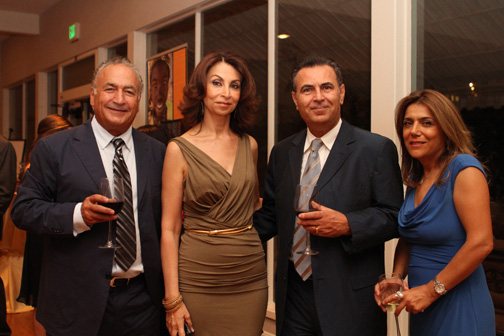 |
 |
 |
 |
 |
 |
 |
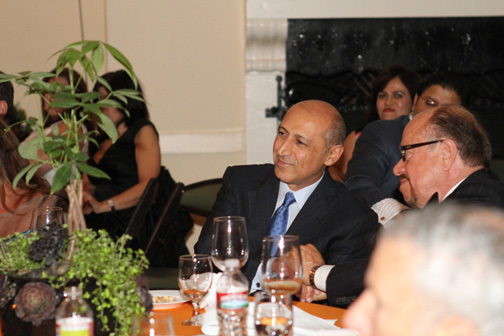 |
 |
 |
 |
 |
|
 |
 |
Fact of the Week
|
|
How to Save an African Starfish
by Kristin Allen
 |
While walking along a beach, an elderly gentleman came across a young man picking up starfish, one by one, and tossing each one gently back into the water.
He called out, “Good morning! May I ask what it is that you are doing?”
The young man paused, looked up, and replied “Throwing starfish into the ocean.”
The old man smiled, and said, “I must ask, then, why are you throwing starfish into the ocean?”
To this, the young man replied, “The sun is up and the tide is going out. If I don’t throw them in, they’ll die.”
Upon hearing this, the elderly observer commented, “But, young man, do you not realize that there are miles and miles of beach and there are starfish all along every mile? You can’t possibly make a difference!”
The young man listened politely. Then he bent down, picked up another starfish, threw it into the back into the ocean past the breaking waves and said, “It made a difference for that one.”
Sometimes, world issues can seem so big, and human suffering so great, that people can’t imagine how as an individual, they can make a difference. When you are dealing with a water scarcity crisis that impacts around 1.2 billion people (almost one-fifth of the world’s population), it seems even more hopeless. However, it is BECAUSE the problem is so enormous that everyone MUST get involved.
Sub-Saharan Africa has the largest number of water-stressed countries of any region on that continent. Niger is the second poorest country in the world. What is the main reason why 1 in 7 infants and children die in rural Niger before the age of 5? Drinking contaminated water. So the bottom line is…. safe water is key, because safe water saves lives.
Wells Bring Hope is saving lives in Niger by drilling wells to bring safe water and sanitation to rural villages. They rely on people like you and me to raise money to help them do it. Once lives are saved by providing safe, clean water to villages, then the people of Niger can actually start LIVING!!
Women and girls walk 4-6 miles a day to get water and with all of their time taken up by this task, girls can’t go to school. When a well is drilled, girls are able to go to school, and women can spend their new found time earning an income through microloans provided by Wells Bring Hope…..and mothers can stop living in constant fear that contaminated water is going to kill their children.
So look in the mirror and ask yourself, “Do I want to save some lives today?” If the answer is “yes”, then you can make it happen through Wells Bring Hope.
Drought vs. Donors in Niger
by Jessi Johnson
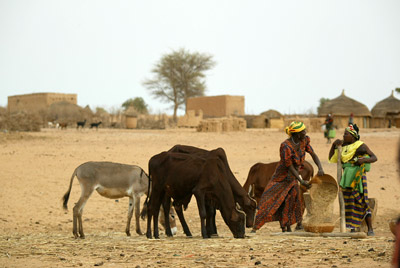 |
| {photo credit: ILRI/Stevie Mann} |
Livestock is life for a family in Niger—the means to pay the dowry for a future bride, the inheritance left for a son, the milk and money that keeps a family alive day to day. The people of Niger are directly linked to their animals and caring for the results in a healthier community. So it is a clear sign of their desperation that the people are selling their livestock—for half the normal value—for a chance to feed their children.
What would bring a people so close to despair that they would willingly sell their daily means of survival, as well their cultural inheritance? Drought after drought after drought has ravaged the homelands of the people for whom selling their last camel, cow or goat is like selling their house and car, just to buy groceries. To make matters worse, Just 15 percent of the land is arable enough to produce food or raise the precious livestock, meaning that most of the country’s farming population is struggling to survive. In a predominantly rural economy, 80 percent of the people rely on subsistence agriculture to survive.
|
|
 |
| {photo credit: ILRI/Stevie Mann} | {photo credit: ILRI} |
Now, for the third time in the last ten years, the country is suffering through a drought. This drought is perhaps no different or harsher than the droughts Niger has survived over the decades. What makes it stand out is the pre-emptive measures taken against it by aid agencies; measures that failed to attract the global attention the drought or the Niger people needed. More than 5 million people in the Sahel region are affected by this drought, and aid organizations wanted to move early before the dire situation became a crisis, but preventative measures are a hard sell when there is no proof to show donors.
We are proud of the work that our partner, World Vision, is doing to provide food relief but it too doesn’t have all that it needs for adequate relief. For Niger, the gap is $4.4 million out of a $16 million relief budget. The rains have returned, but that doesn't mean that food is instantly available, and along with the rain comes flooding that leads to devastating cholera outbreaks. General food distribution, cash transfers, and supplementary feeding programs must continue.
 |
| {photo credit: EC/ECHO} |
The good news is that within the last decade, rich oil deposits have been discovered in Niger and it has enough uranium to become the world’s second-largest exporter of the element. Oil and uranium are two of the global economy’s most sought-after commodities, and if managed correctly, could make Niger one of the more stable and balanced countries in the African continent.
Reference:
Sale of Niger nomad's last camel is sign of camel – Sacramento Bee
Women and the WASH Crisis
by Lauren Adamson
 |
Jeanette A. Brown, Ph.D. spoke about how women have the potential to help alleviate the WASH (Water, Sanitation, and Hygiene) crisis. At the 244th National Meeting & Exposition of the American Chemical Society (ACS), Brown explained that women in rural communities of developing countries often lack access to clean water and hygienic waste facilities. Women in parts of Sub-Saharan Africa fear using nearby latrines because of the risk of sexual assault, whereas the men in most of these communities can relieve themselves in undesignated areas, Brown explained.
Brown also pointed out that women must be seen as a resource in solving this problem and the issue of safe water because, “Women are more likely to commit to projects since they see the value for their children and the community at large. A study by the International Water and Sanitation Centre (IRC) of community water and sanitation projects in 88 communities found that projects designed and run with the full participation of women are more sustainable and effective than those that do not.” At Wells Bring Hope, we have long understood the important role that women must play in transforming villages with safe water. When we drill a well, a committee is formed to oversee and administer that well, and the committee must be at least fifty percent female. In addition, we provide microloans to the women in villages where we drill so that they may use the time they would have spent walking for water to develop small businesses. As Brown points out, if women were given more opportunities like these to work together and be leaders in WASH projects, their work would go a long way in helping their communities and ending the worldwide water crisis.
To read more about Brown’s speech and women helping the WASH crisis, see Women Could Play Key Role in Correcting Crisis in Clean Drinking Water and Sanitation Crisis, published in Science Daily.
Volunteer/Supporter Appreciation Barbecue
by Jessica Isaac
 |
On August 12, WBH Founder and President Barbara Goldberg hosted the annual Wells Bring Hope Volunteer/Supporter Appreciation Barbecue at her home in Los Angeles. The grill was fired up as guests mingled in the California heat, enjoying the shaded backyard and getting to know each other.
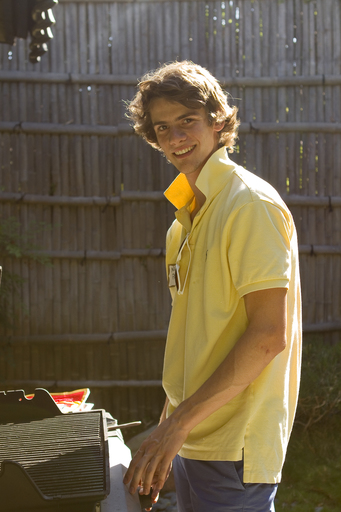 |
|
| {Nick Privatelli mans the grill} |
 |
 |
| {The Frazee Family} | {Nate Damodaran and Nathan Chong} |
 |
 |
| {Lauren McCluskey, daughter Lia, and Gil Garcetti} | {Sharon Croskery and Tamara Hoffman} |
Local musician Xander Smith of Run, Run, Run played an acoustic set while Daniel Yadlosky (videographer) and Kristin Allen (interviewer) took the opportunity to conduct short interviews with the WBH volunteers and supporters to see what really drives the people behind WBH.
 |
 |
| {Daniel Yadlosky films while Kristin Allen interviews Dennis Ogojo and Rosario Lopez of L.A. High} |
{Xander Smith of Run, Run, Run} |
 |
|
| {WBH Director of Microfinance Hadiara Diallo with L.A. students Rosario Lopez and Dennis Ojogho and Dennis’ mom, Esther} |
 |
.jpg) |
| {The Kareem Team – Rosalie, Abigail, and Stephanie} | {The Kilroy family and Barbara Goldberg} |
 |
 |
| {Mandana Azad, Barbara Goldberg, Gil Garcetti, and Alan Azad} | {Melissa} |
 |
 |
| {Rosalie checks out her raffle prize – a copy of Water is Life by our own Gil Garcetti} | {Kevin Kilroy and Kaira Robertson} |
The evening’s presentation began with many thanks from Barbara to those who have donated their time and efforts to WBH. She then presented Dennis Ojogho, a supporter who raised money for WBH by starting a Water Circle at L.A. High, with a graduation gift and congratulated him on his acceptance to Harvard! Dennis then spoke briefly about his involvement with Wells Bring Hope and credited his mother Esther, a native of Nigeria, with inspiring his passion for bringing safe water to West Africa. Finally, another volunteer was highlighted as Nancy Nagel, WBH Grant Team Director, presented the Volunteer of the Year award to Nathan Damodaran.
 |
.jpg) |
| {Barbara Goldberg thanking Dennis Ojogho} | {Dennis and his mom, Esther} |
 |
| {Volunteer of the Year – Nate Damodaran} |
Gil Garcetti, former L.A. County District Attorney and Vice President of WBH kicked off the next round of speakers, one of whom was WBH Director of Microfinance Hadiara Diallo. Diallo shared her experiences going from growing up in Niger, a country where women have no hopes and dreams, to witnessing an increase in hope as WBH provides safe water and microfinance programs to Nigerien women. Kareem Ahmed, Wells Bring Hope’s biggest individual donor, rounded out the evening with inspiring words about his humble beginnings and how giving back has shaped who he is today.
 |
 |
 |
| {Gil Garcetti} | {Hadiara Diallo} | {Kareem Ahmed} |
 |
| {Kareem Ahmed, Barbara Goldberg, and Gil Garcetti} |
 |
|
{Video by Daniel Yadlosky} |
What are we waiting for?

|


